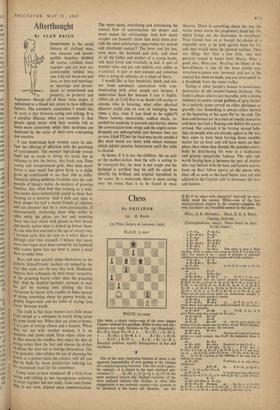Chess
By PHILIDOR 231. H. RINCK (1st Prize, Gazette de Lausanne,.1932) BLACK (9 men)
WHITE (to men)
THIS WEEK, a classic study—one of the most elegant I know—instead of a problem. White to play and win ; solution next week. Solution to No. 230 (Mansfield) : Kt—B 6, threat Kt—K 7. x . . . Kt x Kt ; 2 Q—Kt 8. . . . R x Kt ; 2 Q—R 2. i . . . K x Kt ; 2 B x B. BxP; 2 BxP. ... Bx13; Kt (3)—K 5. Beautiful problem, equally distinguished in key and variations.
One of the most surprising features of chess is the apparent impossibility of ever getting to the bottom of a complex opening variation. Take this week's game, for example ; it is played in the most analysed sub- variation (7 . . Q—Kt 3 ; 8 Q--Q 2, Q x P) of the most analysed branch (the Najdorf variation) of the most analysed defence (the Sicilian) in chess (this exaggeration is not seriously untrue)—the question to be answered is the hoary old chestnut, 'can the
Q Kt•P be taken with impunity?' And still we don't really_ know the answer. White—one of the best correspondence players in the country—supplies his own conclusive and beautiful answer in this game.
White, G, R. MITCHELL. Black, D. E. A. RILEY. Opening, SICILIAN.
(Correspondence, 1964/5. Notes based on these
• P—K 4 Pby the winner.) —Q 11 4
2 Kt—K B 3 P—Q 3 3P—Q4 PxP Kt—K B3 5 Kt—Q B3 P--Q R 3 6 I3—Kt 5 P—K 3
7 P—B Q—Kt 3 This move is good if Black can fo4rKcet p White to spend time saving his Q Kt P; it is bad if he can't. The answer 12 not a matter of principle or positional considerations but of detailed analysis and is still uncertain.
8 Q—Q 2 x P
• R—Q Kt r R 6 P—K 5
/fa . . . to P—K B 5 and to II :• Kt arc alternatives.
roPxP
PxP K Kt—Q 2
rz B—Q B 4 11-1C s 5 52 . . . B—K 2 is the 11101C usual alternative with the current favourite continuation 13 B x K P, 0-0; 14 0-0, 11 x B; 15 Q x B, P—K 3; 16 Q—R 5, P x 57 Kt x P, R x R ch; t8 x KL,Q—K 2; 59 Q-13 5, Kt—Kt 3; 20 Q--B 8 eh, Itax Q; 21 K x Q ch, K—R 2; 22 Kt—B 7, R---R 2; 23 P— 6, Kt—B 3; 24 Kt—K 4, and White has full value for his piece! An illuminating example id the lengths to which analysis is carried, 13 • R—Kt 3 Q—R 4
14 P—Q R3 B--B414. . . Q xP ch; 15 B—K 3 leaves Black over-:exposed and under-developed for his pains— but it may he playable. 15 BxK P BxKt ts . . . PxB; 36 Kt >:K P gives White more than enough for the piece. r6 BxKt ch Ktx11 17 QxB
rd0-0 t—x0P? 18 ...QxP;151QxQ,Ki getting rid of the queens must be better, though VVItite's develop- ment is still value for _pawns. The text loses.
15) Kt—K 4 ti—K 3
ao R—Kt 31 . . . The first of a series of crushing moves and much stronger than B P: the immediate threat is B—R 6.
K—R
21 Kt—B 6! Kt—Kt 3 Necessary to stop Q—R 4. 22 13—R 6! KR—Q If 22 . . . P x11; then 23 x Kt!, K P x H; 24 Kt—R 5 ch, 13-11 3; 25 R x11 and wins. e.g. 25 Q—K 8 ch; 26 R—B r or 25 P x Kt; 26 R—B 7 ch. 22 . . . R—K Kt l giving up the exchange is the only way to A position to sit and admtre prolong the game.
2; R x Kr! . . .
B PxR 23 • . R xR; 24 Q—R 4
indehnitely!
or 23 . P v B; 24 Kt--Q 5 ch.
It would have been still better to play 11 '4 P c
y2.4Kt—t 8, R.x.Q.; R—B 8 ch, B—Kt I; 26 B x P mate. 24 • • • K x B
25 Kt—K 8 Ale ch K—R 3
26 Q—I3 4 ch Resigns z6 . . . 141Q—Kt 4; 27 Q-11 8 ch, K—K 4; 28 Kt—B 6 ch, Q x Kt (28 ... K-11 5; 1:9 Q—K1 4 ch, B—Kt 5; 3o Q—K t mate); 29 Q xQ and wins cusay.






























 Previous page
Previous page